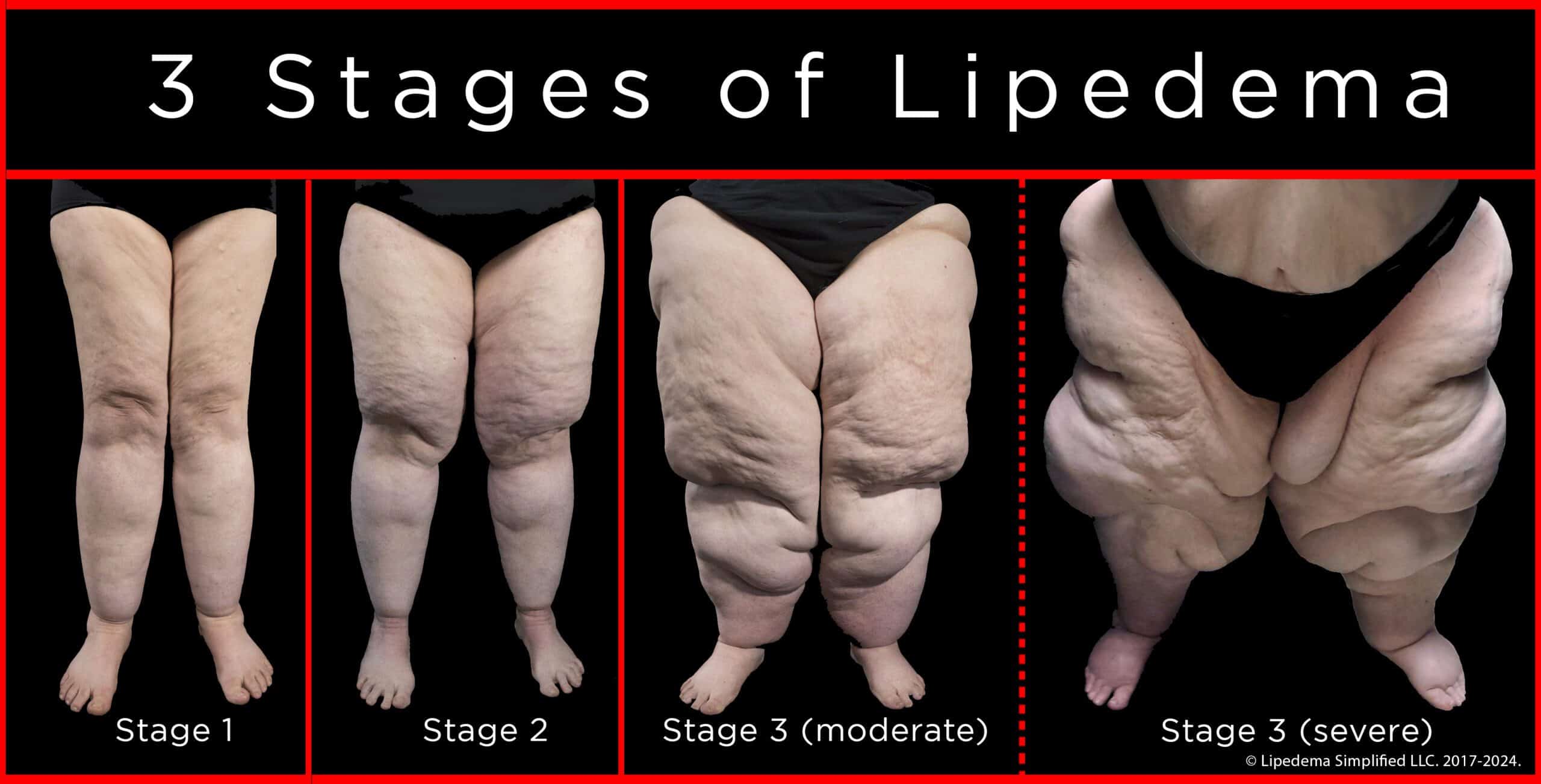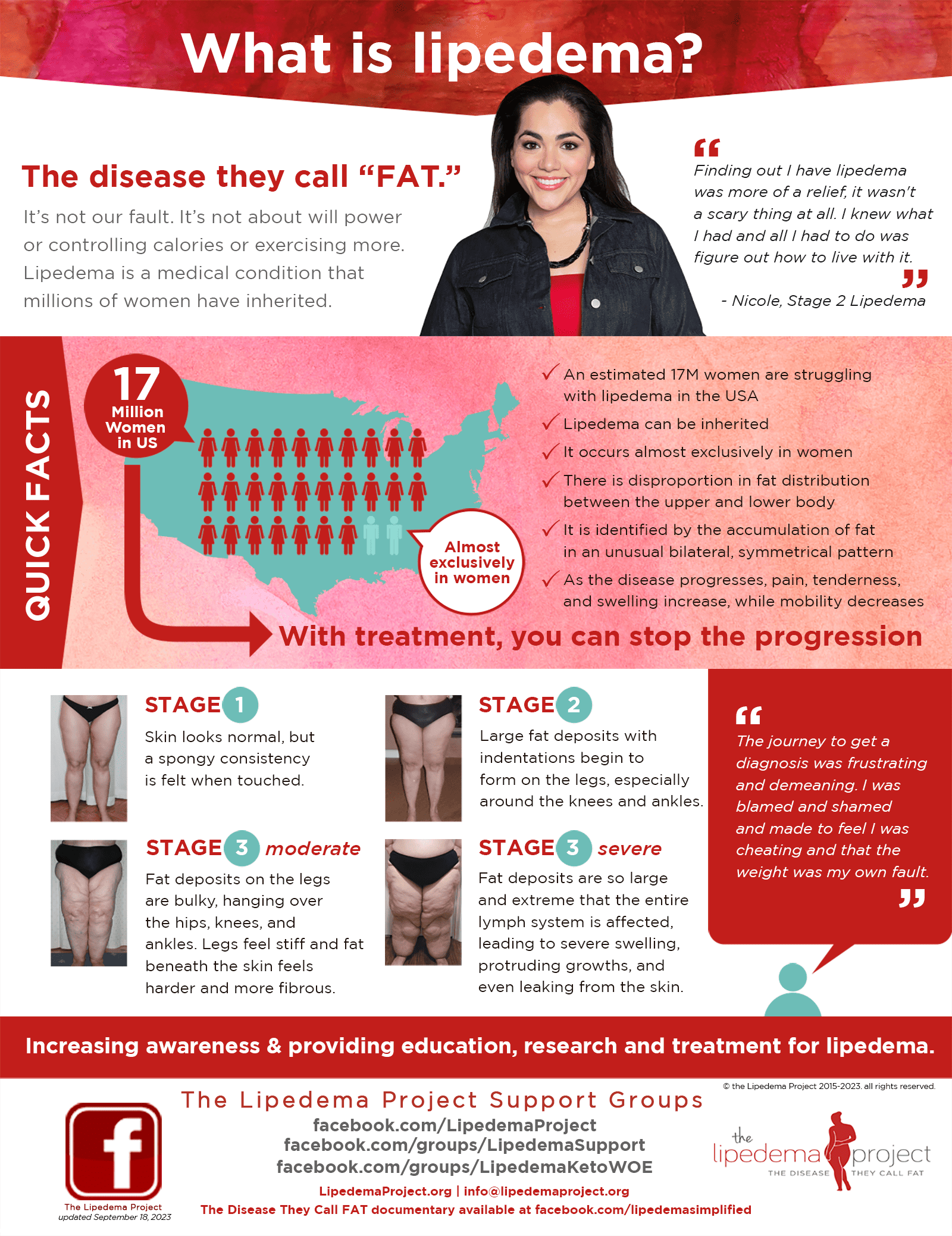What is Lipedema?
Lipedema is a relatively common fat disorder that is often mistaken for simple obesity. Its clinical diagnosis is an adipose tissue disorder or a lipid metabolism disorder. A typical lipedema patient is a woman who struggles with large hips and legs, usually out of proportion to the rest of her body. Lipedema also appears in the upper arms. One of the hallmarks of the disease is that lipedema fat is relatively unresponsive to diet and exercise. These measures may lead to weight loss in other areas, but the size of the hips and legs remains disproportionately large.
Lipedema is both an excess buildup of fat cells in a particular area, and the expansion of those fat cells. Swelling in the interstitial fluid between cells may increase during the day in patients with lipedema, but does not usually cause “pitting edema.” Patients often complain of tenderness or pain in the fat, and report that they are easily bruised. Lipedema is little recognized in the United States medical community, and many women go undiagnosed for years.
3 Stages of Lipedema
Lipedema is a progressive disease with four stages. Not all patients have lipedema that worsens over time, but many do. Proper diagnosis and treatment for lipedema can prevent or slow the progression, help retain mobility and decrease pain.

Stage 1
- the skin surface can be smooth with enlarging subcutaneous fat tissue
- there can be swelling that comes and goes depending on various circumstances like nutrition intake and weather conditions
- there can be cuffs at the ankles
Stage 2
- the skin surface is uneven with indentations
- there can be the development of nodules in the subcutaneous fat tissue feeling like “beans in a bag”
- there is a visible “dimpling” of the skin
- there can be increasing tenderness and pain
- there can be cuffs at the ankles
Stage 3 (moderate)
- the skin surface increasingly indents with deformations caused by fat growth
- there can be large masses of skin and fat that create folds and overhangs especially at the hips, thighs, and knees
- ankle cuffs are usually present
- when lymphedema develops, there can be subcutaneous tissue thickening and a honeycomb appearance to the tissue due to fluid buildup in subcutaneous fat
- pain and tenderness can worsen considerably during this stage with increasing immobility
Stage 3 (severe)
- the progression of lipedema advances to include a significant compromise of the lymphatic system and resulting lymphedema, referred to as LipoLymphedema
- there can be debilitating “lobules” of skin and fat, typically on the medial thighs and knees, that significantly limit mobility
- swelling can be persistent
- typically there are profuse cuffs at the ankles
5 Types of Lipedema

There are 5 types of lipedema.
Type I
1. Buttocks
Type II
1. Buttocks
2. Hips
3. Thighs
4. Up to the knees
Type III
1. Buttocks
2. Hips
3. Thighs
4. Calves up to the ankles
5. Feet are spared
Type IV
1. Upper arms
2. Generally, accompanies Type III
Type V
1. Calves
2. Knees to ankles
Lipedema Facts
- Lipedema’s trademark is the excess deposition and expansion of fat cells in an abnormal and particular pattern in the legs. There is usually bilateral and symmetrical (both legs, fairly even) swelling of the legs and hips extending from the waist to the ankles, with the fat forming a ring or cuff just above the ankle. The feet are usually unaffected. Lipedema may occur in the upper arms as well.
- Lipedema occurs almost exclusively in women. There are a few rare cases where lipedema has been diagnosed in men.
- Lipedema fat is resistant to diet and exercise. Although diet and exercise can help both pain and mobility, they are unlikely to change the disproportionate size of the legs or arms for lipedema patients in any significant way.
- Lipedema can occur in women of all sizes, ranging from seriously underweight to morbidly obese. Being thin is not a guarantee that someone does not have lipedema.
- Lipedema seems to have a genetic component. In some families it is inherited through a maternal lineage, so a grandmother, mother, and daughter might all have lipedema. Males can be carriers, so daughters can also inherit from a paternal lineage.
- Lipedema is thought to be affected by hormones. Some women see the first signs of lipedema around puberty. Others first show symptoms around pregnancy or perimenopause. Cases of lipedema have also appeared following gynecological surgery or after major trauma or surgery. These triggers are predominantly periods of major stress and/or high hormonal disturbance.
- Lipedema is more common than you think. Estimates of the incidence of lipedema vary widely, ranging as high as 11% of the post-puberty female population. That would mean close to 17 million women in the United States alone, and as many as 350 million women worldwide.

